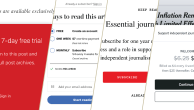Q. The Pew Internet & American Life Project has tracked the growing importance of the Internet and digital media and how these tools have been used during past campaigns. What kinds of new trends are you expecting to see in the 2012 campaign?
One of the most exciting things about our work studying politics is that each campaign cycle since 1994 has generated its own internet story. We expect that to happen again in 2012.
A little history: in 1994, the story was the appearance of the first campaign web site, by Senator Diane Feinstein. In 1996, web politics turned presidential. One of the top stories that year occurred when Republican nominee Bob Dole gave the wrong URL for his site during a nationally televised debate. But he didn’t seem to suffer any serious problem from the gaffe, demonstrating how peripheral internet politics was to the basic structure of a campaign just a decade ago.
By 1998, some clear internet effects began to emerge. Independent Jesse Ventura stunned the Minnesota political establishment by conducting an insurgent campaign that featured email communications. Two years later, GOP presidential candidate John McCain proved that candidates could raise a lot of money online and harness the power of the Internet as a source of political news and information.
During the 2002 midterm elections, work by the Pew Research Center’s Internet & American Life Project and the Center for the People & the Press showed that many voters were turning to the internet to get political information from multiple sources. The newest class of websites shaping online politics that year was interest group and advocacy organization sites.
In 2004 presidential race, Howard Dean’s campaign demonstrated how social networking tools like blogs and meetups could be effective in generating voter interest, recruiting and motivating volunteers and changing the interplay between citizens and campaigns.
The 2006 midterm election campaign was perhaps most famous for the rise of online video, highlighted by Virginia Republican George Allen’s “macaca” video. Additionally, robo-calls (pre-recorded telephone calls soliciting votes) became a prominent part of the political environment.
The main story of the historic 2008 presidential race was the way in which all kinds of social media tools came to prominence: Our survey and report demonstrated the importance of candidate Facebook pages, Twitter feeds and texting services. And the 2010 race was notable for innovation in the mobile space and the growing reliance of voters on social networking sites and Twitter.
As we plan for the 2012 race, we’ll be paying attention to how these previous trends extend themselves. We’ll be looking for changes in social media use of all kinds and for more activity tied to mobile connectivity; not only will that include the use of texting (which we recently found is increasingly important to people in their general communication exchanges), but we will also ask people for the first time about mobile apps that are tied to political activity. There is already an interesting debate brewing about political apps that has been covered well – see here and here. It will be fascinating to watch which candidates try to exploit this new tool.
Perhaps the biggest phenomenon we’ll try to explore is something that worries a lot of observers: the degree to which people live in political echo chambers. This refers to the degree to which they seal themselves in info-bubbles in which they might only encounter people who share their political views and exchange only similar ideas.
We took a serious stab at exploring this phenomenon in 2004 and came away with findings that did not match the views of those who worry about echo chambers. That was before the rise of Facebook and other social networking sites, so there is reason to return to our study of this concept with fresh ideas and new questions.
Lee Rainie is Director of the Pew Internet and American Life Project




